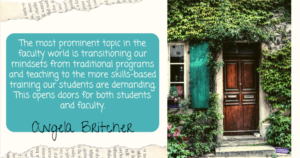
The First Days of Class: Building Authenticity and Community
Regardless of whether you’ve been teaching for 15 years or 15 minutes, how to act and what to do on the first day of class

Regardless of whether you’ve been teaching for 15 years or 15 minutes, how to act and what to do on the first day of class

One of the most intriguing, and perhaps intimidating, aspects of walking into a class for the first time and introducing yourself is deciding who you

This week on The Focus is You, we’re getting to know Angela Britcher who works in instructional design, faculty training, and content writing. We’ve catered

I started teaching economics in higher education almost a decade ago, and yet the memory of the first time I asked a student to meet

In-class activities can be a great way to foster student engagement in the classroom. Depending on the activity, the results can vary greatly. Sometimes they

All too often I have heard colleagues pondering over situations in which students are found on their smart phones rather than engaged in class. As

As college faculty, we put tremendous pressure on ourselves to talk. We want to cover the course content and thoroughly explain our assignments. We want

Igniting an emotional connection to content inside the classroom can be a powerful tool for student retention, but intertwining technology and emotion in the classroom

In the world of diets, movements are the thing that sells…Vegan, Paleo, Whole 30, Keto, and, now, Carnivore (…seriously, it’s a thing). Yet, upon closer inspection, many of these diets perform similarly in the long run, which is to say they perform underwhelmingly. When a dieter fails to get the pseudoscientific benefits promised, they are likely to blame themselves. They relapsed, cheated, or otherwise failed to follow instructions (succumbing to the fate of being an imperfect human being). It is less likely that we question the diet. Instagram before and after posts abound. Diets can put people in a bind: why won’t this work for me? Given the gap between basic principles (eat your vegetables, less processed foods) and the dos and don’ts of diets, it’s worth asking what value diets add to our lives.

Because I teach mixed demographic courses, I often look out at a sea of distracted and unmotivated faces. Motivation is a large part of learning (Pintrich and deGroot, 2003). So, I use active learning activities, such as think-pair-share, to not only motivate students (Marbach-Ad et al., 2001), but also to enhance student learning (Bonwell and Eison, 1919; Freeman et al., 2014). If I’m being honest, active learning also has the added perk of distracting students from the monotony of my voice. Yet, in the past few years, I have begun to wonder if I have taken it too far? Am I simply using active learning as a way of keeping bored students active?
Get exclusive access to programs, reports, podcast episodes, articles, and more!